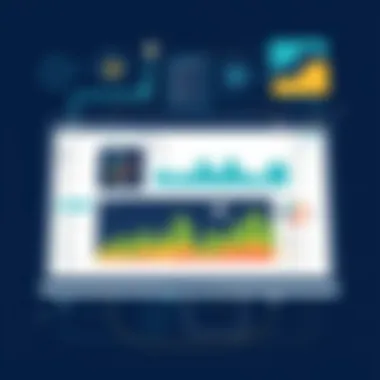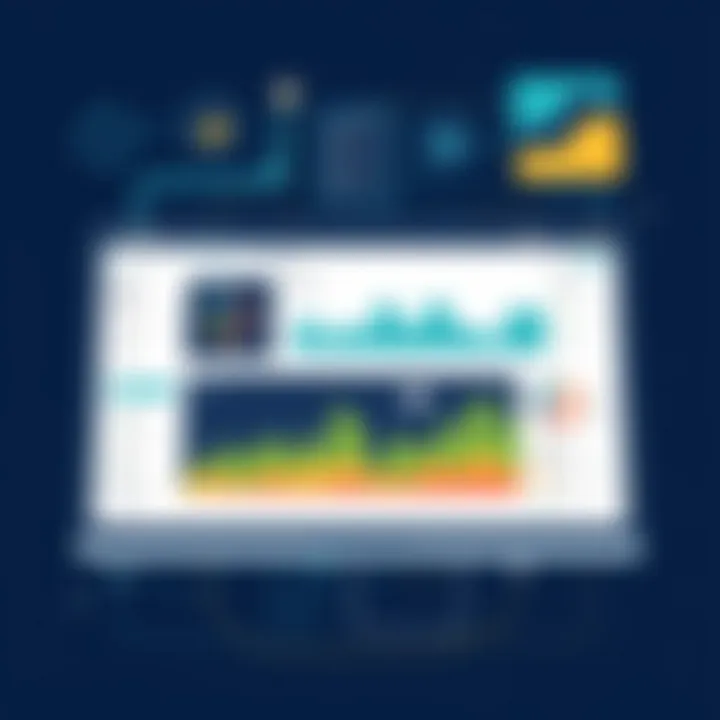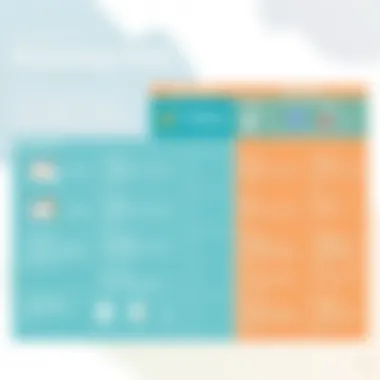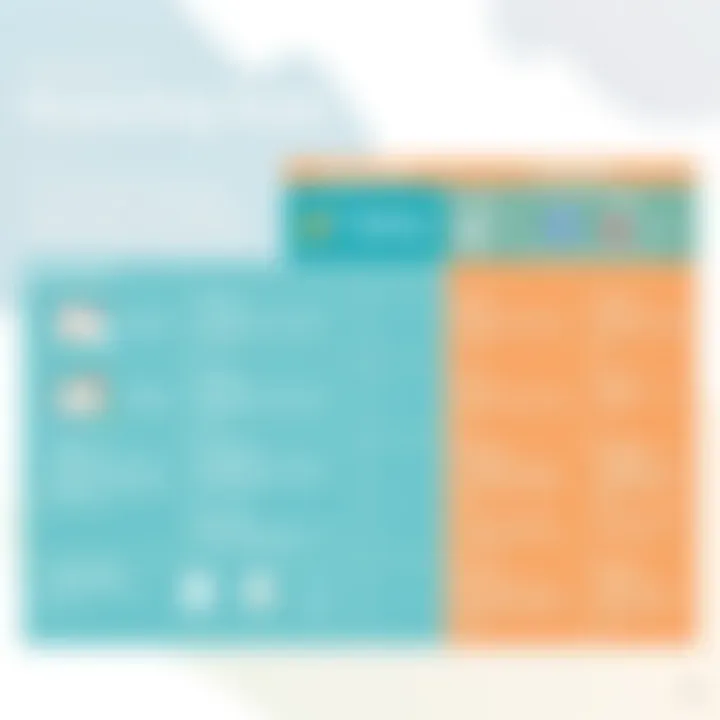Understanding the Tableau Reporting Tool: A Comprehensive Overview


Intro
The influx of data in today’s corporate landscape has turned the ability to analyze and visualize information into a cornerstone of informed decision-making. As organizations strive to extract meaningful insights from raw data, tools that facilitate these processes often become indispensable. One such tool, widely recognized for its robust capabilities, is Tableau. This reporting software has transformed how businesses handle their data, enabling users to create rich visualizations and meaningful reports without needing deep programming skills.
In this article, we will peel back the layers of Tableau's features and functionalities, examining its applications across a variety of sectors, including finance, healthcare, and education. Alongside, we’ll discuss the essential skills needed for users to harness this software's full potential. You will also find a comparison with other reporting tools, allowing for a clearer perspective on how Tableau stacks up in a crowded marketplace. Understanding its limitations and strengths will equip IT professionals, software developers, and business managers to make better software adoption choices, paving the way for data-driven success.
Software Overview
Software Description
Tableau is fundamentally a data visualization tool that excels in turning complex data sets into actionable insights. With its user-friendly interface and intuitive features, it enables users to connect to various data sources, including spreadsheets, databases, and cloud services. The key appeal of Tableau lies in its ability to produce interactive dashboards and reports that can be easily shared within teams or organizations.
This software has gained traction due to its versatility, serving a broad audience from analysts performing in-depth research to executives seeking high-level overviews. The capability to visualize trends, patterns, and anomalies in the data not only enhances comprehension but also aids in strategic planning.
Key Features
Tableau packs a punch with an array of features designed to enhance data analysis.
- Drag-and-Drop Interface: Users can effortlessly create visualizations without coding, thanks to its intuitive drag-and-drop functionality. This significantly lowers the barrier of entry for new users.
- Dynamic Dashboards: Tableau allows for the creation of interactive dashboards that provide real-time insights and facilitate user interaction.
- Multiple Data Connections: Whether it’s an Excel spreadsheet or a complex SQL database, Tableau connects seamlessly to various data sources, making it a versatile choice.
- Data Blending: The tool can combine data from different sources, allowing users to create comprehensive reports that draw insights from multiple datasets.
- Mobile Compatibility: With the rise of remote work, Tableau’s mobile app ensures that users can access and analyze data on the go, ensuring flexibility and convenience.
"Tableau transforms raw data into visual stories, making analytics not just informative, but engaging."
User Experience
User Interface and Design
One of the standout features of Tableau is its clean and organized user interface. The workspace is well-structured, making navigation straightforward. Users can quickly locate tools, components, and data sets, fostering a smoother experience. The design prioritizes usability without sacrificing functionality. Moreover, the learning curve is relatively gentle, allowing users to pick up different features in a timely manner, which is crucial in fast-paced environments.
Performance and Reliability
When it comes to performance, Tableau holds its ground well. The software efficiently handles substantial amounts of data without significant lag, which is vital for organizations that rely on real-time analytics. However, like any other tool, it does have its limitations. Users may experience issues with data refresh rates during peak demand times, which can impede decision-making processes. But overall, Tableau's reliability in generating accurate reports and visuals strengthens its position in the analytics market.
As we delve deeper into the specifics of Tableau's functionalities and applications, it becomes increasingly clear that this tool isn't just another software option; it’s a powerful ally in the realm of data visualization and analysis.
Foreword to Tableau Reporting
The landscape of data analysis is ever-evolving, and with it, the tools that empower professionals to make sense of data. Tableau, as a reporting tool, stands at the forefront of this transformation. An introduction to Tableau Reporting enlightens readers on not just the functionalities of the tool, but also the broader implications of its use in organizations today.
For IT professionals and software developers, understanding how Tableau operates can significantly improve efficiency in data visualization and reporting. The robust features of Tableau enable users to transform intricate data sets into meaningful, interactive visual stories. This can help even non-technical users grasp complex concepts with ease. As the old saying goes, "a picture is worth a thousand words,” and that remains especially true in the realm of data where representation can often make or break insights.
Over the years, businesses of all sizes — from small startups to large multinational corporations — have started to integrate Tableau into their workflows. The primary reason? Enhanced decision-making capabilities. When data is presented in a clear, visual format, it allows stakeholders to identify patterns and trends quickly. This can be the difference between reacting to market changes versus anticipating them, thus staying ahead of the competition.
That said, as useful as Tableau can be, it is critical to approach it with the right expectations. One needs to consider the initial learning curve, the need for proper training, and the importance of ensuring data accuracy. After all, improper use of such a powerful tool can lead to misleading conclusions.
What is Tableau?
Tableau is more than just a reporting tool; it’s a comprehensive system designed to transform raw data into insightful visual stories. Understanding what Tableau is and how it functions is crucial in today's data-driven landscape, especially for IT and software professionals. At its core, Tableau empowers users to connect to a myriad of data sources, unearthing patterns and trends that may go unnoticed in raw data. This capability leads to more informed decision-making across all levels of business.
Overview of Tableau Software
Tableau Software is a powerful platform that enables users to visualize, analyze, and share information effectively. Launched in 2003, Tableau has since evolved to become a household name in the realm of data analytics. The platform’s ability to simplify complex data sets into user-friendly visualizations is what sets it apart from competitors. It supports various data forms, from spreadsheets and databases to cloud services, making it suitable for organizations of all sizes.
Tableau’s versatility is one of its greatest strengths. Users can create interactive and shareable dashboards that illustrate changes in key performance indicators (KPIs) over time. This deep dive into data not only improves analytics but also enhances storytelling, bringing data to life in ways that spreadsheets simply cannot.
Key Features of Tableau
The features of Tableau are designed to cater to a variety of end-users, from analysts to business executives. Here are some of the key attributes that define this reporting tool:
Data connectivity
One of the standout features of Tableau is its extensive data connectivity. Users can connect to numerous data sources, including SQL databases, Excel files, and even big data frameworks like Hadoop. With this level of connectivity, Tableau allows users to pull in data from diverse platforms, merging them into one seamless view.
The key characteristic of this data connectivity is its real-time integration. This means that whenever data changes in the source, it reflects instantly in Tableau, ensuring that decisions are made on up-to-date information. This feature is undeniably popular; it eliminates the arduous task of manual data collection and brings efficiency to reporting processes.
Using Tableau’s flexibility, users can blend various data sets without requiring extensive programming knowledge. This reduces the time spent on gathering data, allowing more focus on analysis and interpretation. However, one must consider that depending on the volume of data and connection type, users may experience performance lags during heavy usage times.
Data visualization capabilities
Tableau is renowned for its robust data visualization capabilities. It provides a range of visualization options, from simple bar charts to complex scatter plots and heat maps. This richness in visual choices facilitates a clearer understanding of data, enabling users to detect anomalies and trends effectively.
The primary attraction of Tableau’s visualization is its ability to present data insights in a visually engaging manner. A key feature here is the drag-and-drop functionality, making it straightforward for users to create compelling visuals without any advanced knowledge of design principles. This accessibility boosts productivity, as users can spend less time on formatting and more time on discovering insights.
Nonetheless, there are drawbacks; some users may find that too many visualization options can lead to analysis paralysis. With so many choices, selecting the right visualization might be challenging, especially for newcomers trying to tell a specific story with their data.


Interactive dashboards
Interactive dashboards are another critical element that makes Tableau stand out. These dashboards allow users to engage directly with the data, filtering and drilling down to explore specifics without cumbersome processes. The capacity to click through visuals to reach deeper insights is invaluable for data exploration.
The hallmark of these dashboards is their user-friendly interface, which can be customized extensively. Users can create multi-layered dashboards that tell a comprehensive story, combining several visualizations that can be manipulated in real-time. This feature is particularly beneficial in corporate settings where swift decision-making is required based on various data inputs.
While the advantages are clear, it’s worth noting that creating complex interactive dashboards might require a more considerable learning curve. Users who are accustomed to traditional reporting tools may find the initial transition demanding, but in the long run, the interactive nature pays dividends in terms of insight generation.
"Tableau transforms the way data is perceived, not just as numbers, but as narratives woven into a meaningful dialogue with the viewer."
Tableau, in essence, encompasses a world of possibilities for users. By understanding what Tableau is and delving into its features, professionals are better equipped to leverage its potential effectively.
Importance of Reporting Tools
In an age where decision-making is increasingly driven by data, reporting tools have become essential for businesses of all sizes. They serve as a bridge between raw data and actionable insights, allowing organizations to make informed decisions. The advantages of utilizing reporting tools like Tableau are numerous. They simplify the complex process of data analysis, making it accessible to professionals who may not have a technical background. This democratization of data empowers teams to identify trends and anomalies, enabling proactive rather than reactive strategies.
Role in Data Analysis
Transforming raw data
Transforming raw data refers to the process of converting unstructured or semi-structured data into a structured format suitable for analysis. This is a critical step in the reporting journey. By utilizing Tableu, users can easily shape and mold their data, eliminating the clutter often present in raw formats. The key characteristic of transforming raw data is its capacity for cleaning and filtering, which is immensely beneficial for any data analysis process. For instance, when handling sales data, raw figures may include incorrect entries or duplicates. Tableau's data cleaning tools ensure that users can easily streamline their data, leading to more accurate insights and reporting.
One unique feature of this transformation process in Tableau is its ability to connect to a multitude of data sources, offering a comprehensive view of a company's performance. However, while the benefits abound, there are potential downsides as well. Those with minimal data literacy may struggle to understand or properly execute transformations, resulting in potential inaccuracies if not handled correctly.
Identifying trends and patterns
Identifying trends and patterns is another cornerstone of effective data analysis. This process allows stakeholders to understand not just what the data says but also the underlying narratives that can influence decision-making. In Tableau, visual tools such as heat maps and trend lines facilitate this crucial analysis. The ability to visualize data makes spotting trends much simpler, turning what may be a mountain of numbers into a straightforward visual representation.
The key characteristic of identifying trends is its timeliness; discovering fluctuations in data can lead to immediate business adjustments. For example, an increase in customer inquiries about a particular product can signal a need for inventory replenishment before stock runs out. This proactive identification is vital for organizations striving for efficiency.
While being beneficial, the challenge lies in interpreting these patterns accurately. Misinterpretation can lead to misguided conclusions, so it's essential that professionals are trained in analytical skills to complement the visualization capabilities of Tableau.
Impact on Decision-Making
The impact of sophisticated reporting tools like Tableau on decision-making cannot be overstated. These tools facilitate rapid interpretation of data, allowing leaders to pivot strategies almost on the fly. Reporting tools contribute to creating a culture of data-driven decision-making inside organizations. When data is easily accessible, teams across departments—from marketing to finance—are better equipped to act on insights gathered.
Additionally, cohesive reports foster communication among stakeholders. This leads to a clearer understanding of objectives and goals, streamlining efforts across functions. The visual representations help stakeholders see the "big picture" while also allowing for granular insights into specific data points.
Tableau's Data Visualization Techniques
The importance of Tableau's Data Visualization Techniques in today’s data-driven landscape cannot be overstated. These techniques allow users to interpret complex datasets easily and intuitively, helping them make informed decisions based on visual insights. Tableau transforms raw numbers into meaningful patterns, enabling stakeholders across various industries to glean deep insights that might otherwise be obscured. By leveraging unique features and best practices, Tableau users can maximize their reporting effectiveness and enhance understanding.
Understanding Visual Elements
Charts and graphs
Charts and graphs are among the most fundamental visual elements in Tableau, serving as the backbone of data representation. Their primary contribution is to simplify vast amounts of data into digestible visual formats. A key characteristic is their ability to illustrate relationships and trends over time or between variables, making them a beneficial choice for analysts looking to convey complex information without overwhelming the audience.
One unique feature of Tableau's charts and graphs is the interactivity they offer. Users can drill down into data points, zoom into specific time frames, or highlight trends with just a click. This interactivity not only enhances user engagement but also refines data storytelling. While charts and graphs may suffer from potential misinterpretation if poorly designed, when used correctly, they become invaluable tools for data storytelling.
Maps and geographical data
Maps and geographical data provide another layer of depth in Tableau’s visualization arsenal. They allow for the geographical analysis of data points, offering insights that are simply unattainable through traditional formats. A primary characteristic is the ability to display information relative to geographic locations, which is a popular choice for sectors like healthcare or real estate that rely on location-based data.
What's truly unique about Tableau’s maps is their ability to integrate various data sources seamlessly. For instance, one might visualize population density alongside healthcare access in a region. This dual-layer visualization provides a potent insight into how different factors correlate with each other spatially. While maps can sometimes miss the nuances of data distribution, they shine when illustrating trends such as regional sales performance or demographic shifts.
Best Practices in Data Visualization
To achieve the best results with Tableau, one must adhere to a few best practices in data visualization. These practices help maintain clarity and purpose, ensuring the visualizations serve their intended goals:
- Keep it simple: Avoid cluttering visuals with unnecessary elements that can distract from the main point.
- Use appropriate scales and labels: This helps to accurately convey the data without misrepresentation.
- Leverage color effectively: Utilize color coding not just for aesthetic appeal but also to enhance understanding. Different colors can signify trends, categories, or critical points.
- Test your visuals: Run your visualizations past colleagues or friends to gather feedback on clarity and comprehensibility.
By implementing these strategies, users can ensure that their Tableau visualizations not only look good but also effectively communicate the desired message. The right visualization technique, when paired with best practices, opens up a world of insights that can drive impactful decisions.
Tableau in Various Industries
Tableau has carved a niche for itself across various sectors, serving as a potent tool for data visualization and reporting. In an era where data flows like a river, organizations need to harness its power, and Tableau stands out due to its versatility and user-friendly interface. By translating data into easily digestible visual representations, it enables stakeholders to make informed decisions swiftly. The systematic analysis of data is critical in today’s fast-paced environment, and Tableau's adaptability across different industries showcases its significance.
Healthcare Applications
In the healthcare sector, the ability to visualize patient data effectively can lead to improved patient outcomes. Tableau helps healthcare professionals analyze patient records, treatment effectiveness, and operational efficiencies. For instance, hospitals might use Tableau to track patient flow through the emergency department, allowing for better staff allocation and resource management. This can be particularly beneficial during a crisis, like a pandemic, where resources are stretched thin. Moreover, data visualization can assist in identifying patterns in disease outbreaks, enabling healthcare providers to respond proactively.
- Enhanced Patient Care: By analyzing data related to patient histories and treatment plans, healthcare providers can tailor their approaches, ensuring better health outcomes.
- Operational Insights: Data related to hospital workflows can be visualized to identify bottlenecks, reducing wait times and improving service delivery.
Finance and Business Intelligence


In the finance industry, each second can signify millions of dollars. Thus, timely and precise insights are of utmost importance. With Tableau, financial analysts can visualize trends, monitor performance metrics, and evaluate risks efficiently. For instance, investment firms often utilize Tableau to analyze stock market trends and portfolio performances, guiding their strategic decisions. Furthermore, budgeting and forecasting can evolve from guesswork to precise estimations with the right data visualized in Tableau.
- Risk Management: Through real-time data analysis, financial institutions can spot anomalies quickly and react accordingly, minimizing potential losses.
- Performance Tracking: Organizations can visualize their financial health through dynamic dashboards that showcase key performance indicators, making reporting more straightforward for stakeholders.
Education and Research
In education, Tableau empowers institutions to harness their data for enhanced academic performance and operational efficiency. Schools and universities can track student progress, analyze attendance rates, and even evaluate faculty performance, ensuring that all decision-making is data-driven. By visualizing these datasets, educators can pinpoint areas needing improvement and tailor their educational approaches based on real insights. For example, using Tableau to analyze student grades over time can help identify which programs are underperforming and require adjustments.
- Data-Driven Decisions: Institutions can make informed decisions regarding curriculum changes, resource allocation, and student support services based on analytical insights.
- Research Visualization: Academic researchers can present complex datasets in a more digestible format, helping to convey findings effectively during presentations or publications.
"In an age where decisions must be backed by solid evidence, Tableau's role in various industries brings clarity to chaos, ensuring that organizations navigate through their data landscapes more effectively."
Engaging with Tableau's diverse applications allows industries to extract meaningful insights that ultimately drive progress and foster innovation.
User Experience with Tableau
User experience (UX) is a crucial aspect of any software platform, and Tableau is no exception. A well-designed user experience can significantly impact how effectively users can navigate, analyze, and visualize their data. This section delves into the user interface of Tableau and its accessibility features, shedding light on what makes this tool intuitive yet powerful, catering to users ranging from novices to seasoned professionals.
User Interface Overview
Tableau's interface stands out as sleek and polished, designed with the user in mind. At first glance, the layout is uncluttered, allowing users to focus on their data instead of being bogged down by unnecessary distractions. The interface is organized into three main sections: the workspace, data pane, and shelf. This division promotes ease of use, so finding necessary tools is often a breeze.
- The Workspace: This is where the magic happens. Users create visualizations here by dragging fields from the data pane onto the central canvas. The flexible layout allows for a seamless flow of actions, simplifying the process of building complex reports.
- Data Pane: On the left side, the data pane displays the available data sources. Users can easily connect to various data sources, be it Excel files or cloud databases, further enhancing accessibility.
- Shelves: Above the workspace, the shelves provide dedicated spots for adding dimensions and measures, offering users a straightforward method to arrange visual elements, be it graphs or tables. Within this framework, the drag-and-drop functionality not only accelerates the analytical process but also invites experimentation, empowering users to iterate quickly.
"Tableau balances a sophisticated approach to data analytics with a user-centric design philosophy. Even those less tech-savvy can feel at home."
These structural elements combine to create an environment where exploration is encouraged. Learning to use Tableau's features often feels more like engaging with an interactive art project rather than completing a chore. This engagement is further echoed in how visual feedback is provided, like instant previews of changes, which fosters immediate understanding of how data alterations affect the visual outputs.
Learning Curve and Accessibility
Despite its robust capabilities, the learning curve associated with Tableau is often cited by new users as a potential hurdle. Yet, its accessibility features are devised to alleviate that challenge. Tableau offers extensive documentation, including video tutorials that can guide users through the initial steps.
- Diverse Learning Resources: Not only does Tableau provide official learning paths, but it also benefits from a vibrant community. Forums such as Reddit or discussions on Facebook are filled with experienced users who freely share their knowledge, insights, and best practices.
- Interactive Tutorials: Tableau’s intuitive structure allows for interactive learning as users can start right away with basic data sets to hone their skills. This hands-on method enables users to learn through practice rather than solely relying on theoretical understanding.
- Customization Options: Accessibility extends to how users can tailor their workspace. Various options allow for adjusting contrast, font sizes, and even keyboard shortcuts to improve usability for those with specific needs. In today's fast-paced business environment, these features not only cater to individual preferences but also ensure that organizations can deploy Tableau without leaving anyone behind.
Engagement with Tableau leads to a deeper understanding of data insights and encourages collaboration among teams of various skill levels. It empowers its users by allowing them to create compelling narratives using their data. Moreover, as organizations dive deeper into analytics, having software that is both user-friendly and accessible becomes ever more vital.
Skills Needed to Utilize Tableau
In an era dominated by data, the ability to harness and navigate tools like Tableau is paramount. Skills needed to utilize Tableau go beyond simply clicking through the software; they involve a blend of technical capabilities and analytical aptitude. Mastering these skills not only empowers professionals but also enhances the decision-making processes within organizations. Understanding what these skills entail will provide insight into how one can effectively leverage this reporting tool.
Technical Skills
Data Manipulation and Retrieval
Data manipulation and retrieval stand at the forefront of Tableau’s capabilities. This aspect emphasizes the importance of extracting and preparing data from various sources, ensuring it is ready for visualization. By being adept at data manipulation, users can transform raw, unstructured data into a format that’s easily digestible.
A key characteristic of data manipulation is its versatility. It allows users to craft and refine datasets to suit specific business needs, ultimately leading to more accurate and insightful reports.
The unique feature of this skill lies in the integration of data from multiple sources, which is crucial for organizations that rely on diverse data points for their analysis. This process, however, comes with disadvantages, such as the potential for error during extraction or transformation processes. An error in data retrieval can lead to misleading insights, making accuracy in this skill essential for reliable outcomes.
Basic Programming Knowledge
Basic programming knowledge can be a game-changer when utilizing Tableau effectively. This skill relates to understanding fundamental coding concepts, which can aid in creating complex calculations or leveraging the REST API for automation. Possessing a bit of programming know-how allows users to stretch Tableau’s functionalities beyond its out-of-the-box capabilities.
A significant benefit of programming knowledge is its potential to create custom functions. For instance, if a user wants a unique metric that isn't available within Tableau's default options, they can write a script to derive that metric. However, not all users will find this straightforward. The unique feature of coding skills is that they can dramatically enhance the power of analysis, but not everyone is comfortable diving into code, which might add a layer of complexity.
Analytical Skills
Equally important are analytical skills, which often define how effectively a user can interpret the data represented in Tableau. These skills concern the ability to draw insights from visual representations, recognize patterns, and make data-driven decisions based on findings.
With strong analytical skills, users can turn data into compelling narratives. They help in answering critical business questions, analyzing historical trends, or predicting future outcomes based on current data. The uniqueness of this proficiency stems from its synergy with Tableau’s visualization capabilities. Users without solid analytical skills may struggle to make sense of the data visuals, potentially missing crucial insights.
In summary, mastering Tableau demands a blend of technical and analytical skills. Data manipulation and programming knowledge lay the foundation for effective usage, while analytical prowess allows for deeper insights and informed decision-making. As organizations shift more toward data-centric strategies, these competencies will critically influence performance and outcomes.
Limitations of Tableau
While Tableau shines in its data visualization prowess, it's nonetheless crucial to recognize its limitations. Understanding these constraints can help organizations make informed decisions about whether Tableau is the right fit for their needs. Identifying such limitations not only helps in realistic expectation-setting but also can guide necessary adjustments or customizations when implementing the tool. Moreover, being aware of these challenges allows for better strategic planning in data management and reporting workflows.
Cost Considerations
Tableau can be a significant investment, especially for small businesses or startups. The licensing costs are often on the higher end when compared to other reporting tools available in the market. There are various pricing models—individual, team, or enterprise—and depending on the number of users and the required features, expenses can escalate quickly.
For example, the Tableau Creator license is priced at around $70 per user per month. It provides extensive features but isn’t always feasible for an organization with budget constraints. Additionally, the costs of ongoing maintenance, training, and potential upgrades should also be factored in, as they often lead to long-term financial considerations.


An important aspect that many overlook is the investment in adequate hardware and infrastructure to run Tableau efficiently, especially for large datasets. Without the right environment, performance can suffer, leading to additional troubleshooting costs. To summarize:
- High licensing costs: Initial investment can be a barrier.
- Additional expenses: Maintenance, training, and infrastructure costs can add up.
- Value of features: Ensuring that the investment aligns with actual organizational needs is vital.
Performance Challenges
While Tableau is highly regarded for its capabilities, there are performance challenges users often encounter. As data volume increases, the performance can wane, resulting in slower rendering times for visualizations and dashboards. This can create bottlenecks, especially during crucial reporting periods when time is of the essence.
Another recurring issue is scalability. While Tableau handles moderate-sized datasets with grace, very comprehensive datasets, particularly those exceeding millions of records or complex calculations, can lead to lagging performance. Users report instances where their analytics become unmanageable due to an overflow of data points, severely affecting responsiveness.
Lastly, storage limitations can arise when working with large data volumes. Users might find themselves forced to implement data extracts instead of working with live connections, which can reduce real-time interactivity and lead to outdated insights. Overall, these challenges can be summed up in key points:
- Slower Performance with Large Datasets: Increased data volume impacts loading and rendering speeds.
- Scalability Issues: Handling extensive datasets can strain the tool’s capacities.
- Storage Constraints: Users may need to resort to extracts, limiting real-time analytics.
The performance challenges faced by Tableau can drain resources and hinder the analytical process, thus necessitating careful planning and resource allocation to ensure efficient use of the tool.
Comparison with Other Reporting Tools
When evaluating reporting tools used in the data analysis landscape, it becomes essential to consider various options available in the market. No single tool fits all needs, so understanding the distinctions between platforms like Tableau, Power BI, and QlikView can help organizations make significant decisions about software adoption for their reporting and analytical needs. Each of these tools brings unique strengths and weaknesses, impacting factors ranging from cost to user experience.
In this section, we will delve into two main comparisons: Tableau versus Power BI, and Tableau versus QlikView. We will explore the critical aspects that these comparisons bring to light, including functionalities, user interfaces, and suitability for different organizational needs.
Tableau vs. Power BI
Power BI, developed by Microsoft, is often touted as a competitor to Tableau. While both tools are powerful in their own rights, they cater to slightly different audiences and use cases.
- Cost Structure: Power BI often comes out ahead regarding pricing, especially for smaller businesses or teams with lower budgets. Tableau, on the other hand, may present a higher upfront investment but can justify this with its advanced data visualization capabilities.
- Data Connectivity: Tableau supports a broader range of data sources, allowing seamless integration with various databases. In contrast, Power BI integrates seamlessly with Microsoft products but sometimes lacks broader connectivity.
- User Experience: Tableau offers a more flexible user interface that is often preferred for detailed and intricate visualizations. However, Power BI boasts a more intuitive set of tools, allowing new users to get up and running quickly. Often, this intuitiveness makes it easier for teams already familiar with Microsoft products to adapt.
Tableau vs. QlikView
QlikView has been a staple in the business intelligence market for years, and comparisons with Tableau reveal both competitive advantages and shortcomings.
- Data Analysis Capabilities: Tableau shines in data visualization, emphasizing visuals to spot trends and gather insights. QlikView, however, excels in associative data indexing, allowing users to explore data without being restricted by predefined queries. This flexibility appeals to users who value deep data exploration.
- Deployment Options: Tableau provides both on-premise and cloud options, catering to diverse organizational requirements. QlikView traditionally leaned more towards on-premise solutions, though it has recently expanded its cloud capabilities.
- Community Support and Resources: Tableau has fostered a vast community of users and developers, creating a rich ecosystem of shared resources and forums. QlikView, while having a loyal user base, does not match Tableau’s expansiveness when it comes to community engagement.
"Each tool's capabilities are diverse, and careful examination of organizational needs will drive the best choice for data reporting."
Choosing the right tool is not merely a numbers game; it involves assessing how each tool aligns with the company’s data strategy, user skill level, and reporting needs. The comparisons outlined above give a deeper insight into Tableau’s position against its competitors, guiding organizations in making informed choices as they navigate the dynamic world of data reporting tools.
Future of Tableau and Data Reporting
As we step into a world driven by data, understanding the future of tools such as Tableau is critical. The landscape of data reporting continues to shift, influenced by technological advancements and the growing demands of diverse organizations. The relevance of Tableau in this environment is not merely about data representation but extends to the very pulse of business decision-making. The importance of examining the future of Tableau is twofold: it allows professionals to adapt to emerging trends while also ensuring that they can harness the software's full potential for strategic advantage.
Trends in Data Visualization
The field of data visualization is brimming with innovations that can significantly impact the use of Tableau. One notable trend is the integration of artificial intelligence within reporting tools. AI can automate data analysis, identifying patterns that the human eye may overlook. For instance, features like Tableau's Ask Data leverage natural language processing, allowing users to query their data in plain language. This trend prioritizes user accessibility, simplifying complex data interactions.
Another emerging trend is the use of Augmented Reality (AR) and Virtual Reality (VR) for data visualization. These technologies create immersive experiences that help users understand multidimensional data. An example can be found in sectors like real estate and urban planning, where visualizing 3D spaces can lead to more informative insights during planning phases.
Moreover, the shift toward real-time data analysis cannot be ignored. Organizations are increasingly recognizing the need for immediate insights to respond to market changes swiftly. Tableau's capability to integrate with cloud services enables users to pull live data into their visualizations, further enhancing real-time decision-making capabilities.
Evolving Needs of Organizations
Organizations today face a whirlwind of challenges. The hunger for data is insatiable, with varied business sectors vying for insights that can lead to a competitive edge. Tableau’s flexibility allows it to adapt to these evolving needs. As organizations become more data-centric, there is a pressing requirement for tools to handle larger datasets effortlessly. Tableau meets this need by scaling efficiently, thus supporting businesses whether they are small startups or large multinationals.
Moreover, as businesses look towards collaborative solutions, Tableau addresses this demand by enhancing features that allow for shared dashboards and interactive reports. Many teams now work remotely and require seamless ways to collaborate on data insights, which is something Tableau excels in comprising tools intended for shared, user-friendly accessibility.
In addition, with the increasing focus on data governance and security, organizations must ensure that their data practices comply with regulations like GDPR. Tableau offers comprehensive security measures, enabling data administrators to manage user access and data sharing easily.
"As the needs of organizations change, the tools they rely on must evolve too, ensuring they remain agile and capable of tackling tomorrow's challenges."
In summary, the future of Tableau and data reporting is intertwined with these trends and evolving organizational needs. By staying ahead of the curve, professionals can optimize their usage of Tableau to drive impactful insights, ensuring their strategies remain robust and relevant in an ever-shifting landscape.
The End
Wrapping up our deep dive into Tableau, it’s clear this reporting tool stands as a beacon for anyone serious about data analytics. Its significance within the realm of data visualization cannot be overstated. As organizations increasingly lean on data to inform decisions, harnessing a tool like Tableau becomes paramount.
Tableau offers a myriad of advantages, from its ability to transform complex datasets into interactive dashboards to its robust data connectivity features. This versatility makes it an appealing choice across various sectors, including healthcare, finance, and education. Each sector can leverage Tableau’s capabilities to unearth valuable insights that drive efficient decision-making.
Some key takeaways worth noting include:
- Intuitive Interface: Users often find Tableau's user-friendly design helps them navigate complex data sets with ease.
- Real-Time Analysis: The capability to analyze data in real-time provides organizations with up-to-the-minute insights, which is vital in a fast-paced business landscape.
- Collaborative Features: Tableau facilitates teamwork by allowing multiple users to work concurrently on visualizations.
Despite its many strengths, it’s essential to weigh certain limitations, such as the costs involved and potential performance challenges, particularly with large datasets. Organizations need to consider these factors when deciding to implement Tableau or any reporting tool.
It is also crucial to acknowledge Tableau's positioning amidst other reporting software, such as Power BI and QlikView. Each tool comes with its own set of strengths and weaknesses, making it key for decision-makers to sift through these aspects in relation to their specific needs.
"Organizations that harness the full potential of tools like Tableau are not just adapting; they are pioneering new frontiers in data-driven decision-making."
Looking ahead, the future of Tableau appears promising, especially as trends in data visualization continue to evolve. Companies must remain attuned to the ongoing developments in data reporting tools and the shifting landscape of business needs. Adaptability and continuous learning will be vital for businesses aiming to thrive in an increasingly data-centric world.
In essence, mastering Tableau is more than just learning a tool; it's about embracing a data-first mindset that drives innovation and informed decision-making. This comprehensive overview highlights how integral Tableau is in the modern data analytics space, urging both seasoned professionals and newcomers to invest in understanding and utilizing this powerful tool.







